Related Research Articles
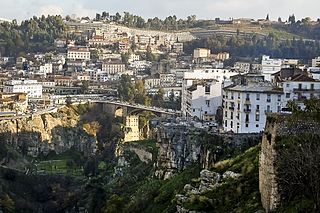
Constantine, also spelled Qacentina or Kasantina, is the capital of Constantine Province in northeastern Algeria. During Roman times it was called Cirta and was renamed "Constantina" in honour of Emperor Constantine the Great. It was the capital of the French department of Constantine from 1848 until 1962. Located somewhat inland, Constantine is about 80 kilometres from the Mediterranean coast, on the banks of the Rhumel River.

Sousse or Soussa is a city in Tunisia, capital of the Sousse Governorate. Located 140 km (87 mi) south of the capital Tunis, the city has 271,428 inhabitants (2014). Sousse is in the central-east of the country, on the Gulf of Hammamet, which is a part of the Mediterranean Sea. Its economy is based on transport equipment, processed food, olive oil, textiles, and tourism. It is home to the Université de Sousse.
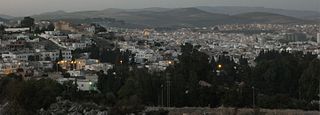
Béja is a city in Tunisia. It is the capital of the Béja Governorate. It is located 105 kilometers (65 mi) from Tunis, between the Medjerdah River and the Mediterranean, against the foothills of the Khroumire, the town of Béja is situated on the sides of Djebel Acheb, facing the greening meadows, its white terraces and red roofs dominated by the imposing ruins of the old Roman fortress.
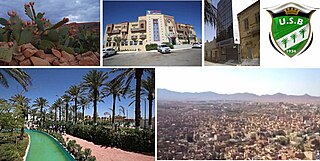
Biskra is the capital city of Biskra Province, Algeria. In 2007, its population was recorded as 307,987. Biskra is located in northeastern Algeria, about 248 miles (399 km) from Algiers, 71 miles (114 km) southwest of Batna and 137 miles (220 km) north of Touggourt. It is nicknamed "The Queen of the Zibans", "The Door of the Desert" or "The Saharan Nice" because of its location at the beginning of the Sahara Desert. Due to its geographical location, its climate and natural resources, particularly farming, Biskra has always been a crossroad between the cities in the north and south. It has seen the passage of several civilizations, from the Romans and the Arabs to the French.

Mauretania Caesariensis was a Roman province located in what is now Algeria in the Maghreb. The full name refers to its capital Caesarea Mauretaniae.
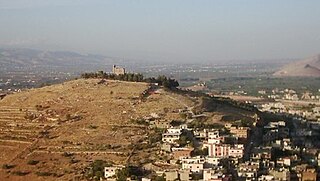
The Beqaa Valley, also transliterated as Bekaa, Biqâ, and Becaa and known in classical antiquity as Coele-Syria, is a fertile valley in eastern Lebanon. It is Lebanon's most important farming region. Industry also flourishes in Beqaa, especially that related to agriculture.

Ifrane is a city in the Middle Atlas region of northern Morocco. The capital of Ifrane Province in the region of Fès-Meknès, Ifrane is located at an elevation of 1,665 m (5,463 ft). In the regional Tamazight language, "ifran" means caves.

The Gulf of Salerno is a gulf of the Tyrrhenian Sea in the coast of the province of Salerno in south-western Italy.


The name early African church is given to the Christian communities inhabiting the region known politically as Roman Africa, and comprised geographically somewhat around the area of the Roman Diocese of Africa, namely: the Mediterranean littoral between Cyrenaica on the east and the river Ampsaga on the west; that part of it that faces the Atlantic Ocean being called Mauretania, in addition to Byzacena. Thus corresponding somewhat to contemporary Morocco, Algeria, Tunisia and Libya. The evangelization of Africa followed much the same lines as those traced by Roman civilization. From the late fifth and early sixth century, the region included several Christian Berber kingdoms.
Sidi Bouzid, sometimes called Sidi Bou Zid or Sīdī Bū Zayd, is a city in Tunisia and is the capital of Sidi Bouzid Governorate in the centre of the country. Following the suicide of Mohamed Bouazizi in Sidi Bouzid, it was the site of the first clashes of the Tunisian Revolution and a catalyst for other protests in the region, often known as the Arab Spring.

Ariana is a coastal city in north-eastern Tunisia, part the agglomeration of Tunis, also called "Grand Tunis". It is located at the north of Tunis city center, around 36°51′45″N10°11′44″E. It is the capital of Ariana Governorate and the country's eighth largest city.
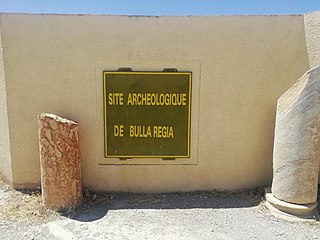
Bulla Regia was a Berber, Punic, and Roman town near present-day Jendouba, Tunisia. Its surviving ruins and archaeological site are noted for their Hadrianic-era semi-subterranean housing, a protection from the fierce heat and effects of the sun. Many of the mosaic floors have been left in place; others may be seen at the Bardo Museum in Tunis. There is also a small museum connected with the site.

Mauretania Sitifensis was a Roman province in Northwest Africa. The capital was Setifis.

Souk Ahras is a municipality in Algeria. It is the capital of Souk Ahras Province. The Numidian city of Thagaste, on whose ruins Souk Ahras was built, was the birthplace of Augustine of Hippo and a center of Berber culture.

Algerian wine is wine cultivated and bottled in Algeria. It has played an important role in the history of wine. Algeria's viticultural history dates back to its settlement by the Phoenicians and continued under the Roman empire. Prior to the Algerian War of Independence (1954-1962), Algeria was the largest wine exporter in the world, accounting for nearly two-thirds of the total international wine trade.

Ras Jebel, also known as Ras el-Djebel, is a town, commune, and archaeological site on Cap Sidi in the Bizerte Governorate of Tunisia. The name of the city refers to the summit or end of the mountain, thus evoking the end of the Atlas Mountains.
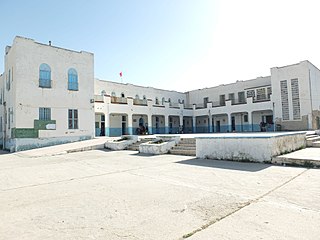
Bou Salem (بوسالم) is a town and commune in the Jendouba Governorate, Tunisia. As of 2004 it had a population of 20,098. by 2014 this had grown 35,192.

Cheffia is a town and commune in El Taref Province, Algeria. According to the 1998 census it has a population of 7,450.
Touccabeur, known in ancient times as Thuccabora, is a railway town and archaeological site in northern Tunisia. It is located in the Medjerda valley, outside of Bou Salem. Touccabeur is located in the Medjerda valley at 36.45N, 8.66E, outside of Bou Salem.
References
- ↑ Sidi-Meskine at mapcarta.
- ↑ "Djema Sidi Meskine". www.getamap.net.
- ↑ "Climate:Sidi-Meskin". en.climate-data.org.
- ↑ Appian, Punica 112.
- ↑ Dennis P. Kehoe, The Economics of Agriculture on Roman Imperial Estates in North Africa (Vandenhoeck & Ruprecht, 1988) p7.
- ↑ About: Thunusuda, Sidi-Meskine.
- ↑ Sidi-Meskine Digital Atlas of the Roman Empire.